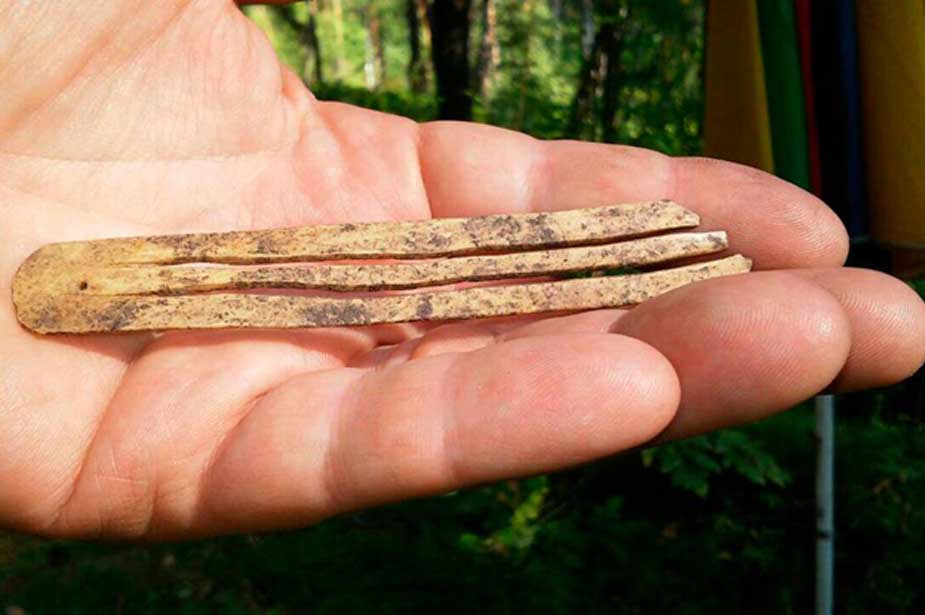This Musical Instrument Still Works 1,700 Years After a Hun Nomad Crafted it!
The nomadic musician looked fondly upon the latest of the completed instruments – a mouth harp carefully crafted by splintering the rib of a cow, or was it a horse? No matter, the sound it made when it was plucked was beautiful – somewhat similar to a flute. Three more of the instruments lay on the bench unfinished…a state they would retain for the next 1,700 years.
Professor Andrey Borodovsky, of the Institute of Archaeology and Ethnography in Novosibirsk, part of the Siberian branch of the Russian Academy of Sciences, announced the discovery of five mouth harps. Also known as Jew’s harps (though there is no connection to Judaism) or jaw harps, Siberian Times reports archaeologists found the musical instruments at two sites of the Altai Republic region of south-central Russia.
The most exciting element of the discovery is that one of the mouth harps can still be used to play a tune some 1,580-to-1,740 years after it was crafted by a member of the nomadic Huns. As Dr. Borodovsky said, “One of the harps is so perfectly preserved that you can play it. But there will be slight sound distortion because a tiny part was damaged.”
- Merciless Marauders or Fearsome Fighters? The Terror Tactics of the Huns
- The End of the Huns: The Death of Attila and the Fall of the Hunnic Empire
National Geographic reports the mouth harp Borodovsky played has a sound similar to a Renaissance-era instrument known as a flageolet, a flute-like instrument. The working mouth harp measures 4.3 inches (11 cm) long and is 3.4 inches (8.6 cm) wide. A musician playing the mouth harp would place the tongue/reed of the instrument in his/her mouth and pluck it with a finger to produce a sound.

An ancient mouth harp found in the Altai Republic of Russia. (Siberian Times)
The Altai mouth harps were created by splintering the middle part of a cow’s or horse’s rib into two parts. This differs from ancient mouth harp manufacturing practices in Mongolia and the Tuva region of Russia, which involved using materials such as deer horns instead of ribs.
Daily Mail points out that mouth harps are among the world’s oldest musical instruments and they were popular in Oceania and Asia. In general, traditional non-European mouth harps were cut from a single piece of bamboo or wood and their European counterparts generally were made as a pear-shaped metal frame with a metal tongue.
Researchers believe the musical instruments found in the Altai Republic were made by Maiminskaya cattle breeders. These individuals were members of the nomadic Hun group – a powerful warrior empire that originated in Central Asia and spread across modern-day Mongolia, Kazakhstan, northeast China, and southern Russia, as well as into Europe – where they became a threat to the Romans.

An ethnographic mouth harp made by an Altaian. (Siberian Times)
Kerry Sullivan explains that the Huns have a terrible reputation as “demonic savages” in history, but the story may have been altered by the Romans, who wrote some biased accounts of what the Huns did, suggesting these people were “evil half-animals whose sole purpose seemed to be to wreak havoc on civilization.”
- The Hurdy Gurdy Was Essential Medieval Entertainment Enjoyed by Merrymakers Across Europe
- Sweet Ancient Melodies of the Ney: One of the Oldest Musical Instruments Still in Use
While that may be far fetched, it is well-known that few historical armies have been seen as terrifying as the Huns. “With this military acumen, the Huns created an empire that stretched east to west from the Caspian Sea to the Rhine River and north to south from the Baltic Sea to the Black Sea” Sullivan writes, however, she continues by stating:
“[…] but most scholars now believe that the Huns were pastoralists who came from Kazakhstan and the eastern steppes. They were forced to move westward as the steppes became increasingly arid, typically traveling in family units or clans. There was little unity among Hunnic peoples and each clan pursued its own agenda. For example, some fought with the Romans, some fought against them.”

Huns in battle with the Alans, 1870s engraving after a drawing by Johann Nepomuk Geiger (1805-1880). (Public Domain)
Top Image: An ancient mouth harp found in the Altai Republic of Russia. Source: Andrey Borodovsky



















